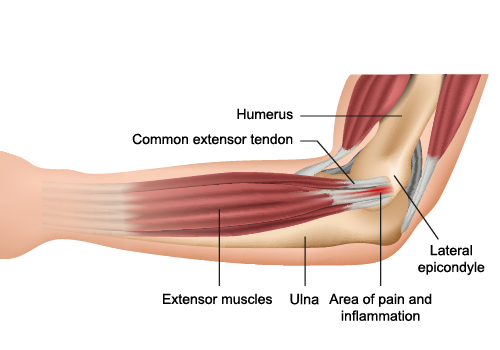Wrist and Elbow problems occur for many different reasons. Years of chronic use can take their toll ultimately causing stiffness, loss of motion and even arthritis.
If you are suffering from a wrist pain and/or elbow injury come to Performance Pain & Sports Medicine for best in class treatment and care.
Often, patients come from other medical practices looking for a solution. We offer fully comprehensive medical care for wrist pain and elbow injuries with our advanced medical treatments from our best-in-class physicians.
Below are the most common conditions that we treat.
Medial Epicondylitis (Golfers/baseball elbow): Medial epicondylitis, also known as golfer's or baseball elbow, is characterized by pain from the elbow to the wrist on the inside (medial side) of the elbow.
Medial epicondylitis is caused by repetitive wrist flexion against resistance or forceful repetitive gripping of the hand. Common symptoms of medial epicondylitis are pain on the same side as the little finger from the palm down the forearm to the elbow. The pain can be felt when bending the wrist toward the palm against resistance, or when squeezing a rubber ball.

Lateral Epicondylitis (tennis elbow): Lateral epicondylitis, tennis elbow, is described to cause pain on the outside (lateral side) of the elbow.
Lateral Epicondylitis is caused by repeated wrist extension against resistance. You do not have to play tennis to develop this condition. Initially, the pain may be felt along the outside of the forearm and elbow, which may increase down to the wrist. Pain may increase during everyday activities such as gripping, picking up a cup, turning a door knob, opening a jar, shaking hands, carrying groceries or turning the steering wheel of a car.

Elbow MCL Tear: A Medial Collateral Ligament (MCL) tear is characterized by overstretching or tearing of the MCL of the elbow.
A MCL tear may range from a small partial tear resulting in minimal pain, to a complete rupture of the tendon resulting in significant pain and disability. MCL tears can occur during activities that place excessive strain on the medial (inside) of the elbow, or due to repetitive strain associated with overuse. Common symptoms include pain at the inner aspect of the elbow. An audible snap may be heard during an excessive strain activity, or the pain may progress over time as with overuse.
Ulnar Nerve Compression: Ulnar nerve compression is a condition characterized by pressure being placed on the ulnar nerve as it runs through the inner aspect of the elbow (funny bone).
Ulnar nerve compression most commonly occurs due to a direct impact to the ulnar nerve, common during a fall onto the elbow or due to direct contact from an object or person. Common symptoms are pain at the back or inner aspect of the elbow and forearm, pins and needles, burning, and numbness.
Carpal Tunnel Syndrome: Carpal tunnel syndrome is a condition in the hand/wrist where compression of the median nerve occurs due to narrowing of the carpal tunnel.
Carpal tunnel syndrome typically occurs in the hand/wrist due to frequent, repetitive, small movements that place repetitive stress through the flexor tendons (such as typing). The most common symptoms of carpal tunnel syndrome are weakness with gripping, pain, numbness, burning/tingling feeling, which can get worse at night.

De Quervains Tendonitis: De Quervains tendonitis is a common overuse condition causing inflammation and swelling in the tendons located at the back /outer aspect of the thumb.
De Quervains tendonitis most commonly is caused by repetitive activities such as golf, tennis, rowing, carpentry, writing, typing, sewing and knitting. Common symptoms of De Quervains tendonitis is an ache or stiffness in the back of the wrist and thumb. This may often be felt at night or first thing in the morning, which may progress and be felt with everyday activities.
Sprained Wrist, Thumb, and Finger: A sprained wrist, thumb, finger is characterized by damage or tearing of the connective tissue (such as ligaments, cartilage and joint capsule) of the joint.
A sprained wrist most commonly occurs due to a specific incident such as a fall onto an outstretched hand. A sprained thumb and finger most commonly occurs due to hyperextension force (backward bending of the thumb or finger), hyperflexion force (excessive forward bending of the thumb or finger) or a sideways force. Pain is usually sudden, but can develop over time.

Wrist Tendonitis: Wrist tendonitis is a common overuse condition which can cause inflammation and swelling of the affected tendons.
Wrist tendonitis most commonly occurs due to repetitive or prolonged activities placing strain on the wrist tendons. Common symptoms are an ache or stiffness in the wrist and/or hand following an aggravating or unaccustomed activity.